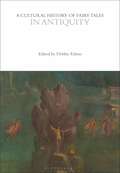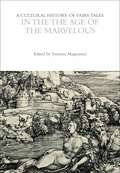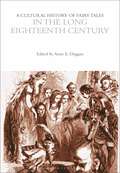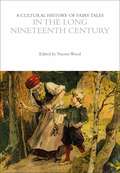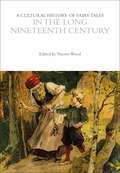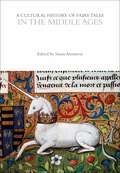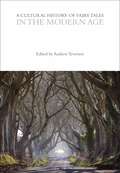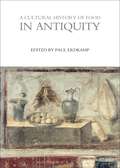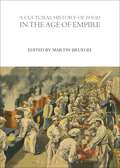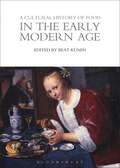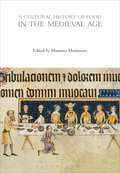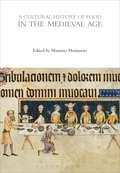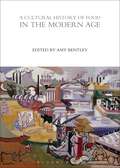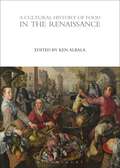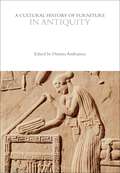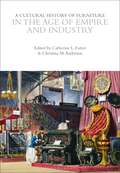- Table View
- List View
A Cultural History of Fairy Tales in Antiquity (The Cultural Histories Series)
How have fairy tales from around the world changed over the centuries? What do they tell us about different cultures and societies? Spanning chronologically from the third millennium BCE through to the seventh century CE and beyond, and geographically from the Mediterranean to the Near East and Asia, this book explores the earliest known evidence of familiar folk tales and fairy tales in the ancient world.Drawing on sources including the Rig Veda, the Epic of Gilgamesh, the Old Testament, the Westcar Papyrus, and the Odyssey, this volume ranges from epic poetry to drama, to fables and proverbs, and from ancient histories to novels.Scholars in Classics, Anthropology, Folklore, and Asian Studies examine the dissemination, adaptation, and cross-cultural interactions of early forms of folk tales, providing new insights into how they functioned and circulated across different societies.An essential resource for scholars and students of ancient literature, history, and cultural studies, this book explores topics including: forms of the marvelous, gender and sexuality, monsters and the monstrous, the significance of spaces, socialization and moral messaging, and the uses and abuses of power.
A Cultural History of Fairy Tales in the Age of the Marvelous (The Cultural Histories Series)
by Suzanne MagnaniniHow have fairy tales from around the world changed over the centuries? What do they tell us about different cultures and societies?Drawing on the contributions of scholars working on Italian, French, English, Ottoman Turkish, and Japanese tale traditions, this book underscores the striking mobility and malleability of fairy tales written in the years 1450 to 1650. The essays examine how early modern scientific theories, debates on the efficacy of witchcraft, conceptions of race and gender, religious beliefs, the aesthetics of landscape, and censorial practices all shaped the representations of magic and marvels in the tales of this period.Tracing the fairy tale's swift movement across linguistic and geographic borders, through verse and prose versions, from the printed page to the early modern stage, this volume demonstrates the ways in which these fantastic literary texts explored the ideological borders constructed by different societies.An essential resource for researchers, scholars and students of literature, history and cultural studies, contributors explore themes including: forms of the marvelous, adaption, gender and sexuality, humans and non-humans, monsters and the monstrous, space, socialization, and power.A Cultural History of Fairy Tales (6-volume set)A Cultural History of Fairy Tales in Antiquity is also available as a part of a 6-volume set, A Cultural History of Fairy Tales, tracing fairy tales from antiquity to the present day, available in print, or within a fully-searchable digital library accessible through institutions by annual subscription or on perpetual access (see www.bloomsburyculturalhistory.com). Individual volumes for academics and researchers interested in specific historical periods are also available digitally via www.bloomsburycollections.com.
A Cultural History of Fairy Tales in the Long Eighteenth Century (The Cultural Histories Series)
by Anne E. DugganHow have fairy tales from around the world changed over the centuries? What do they tell us about different cultures and societies?This volume traces the evolution of the genre over the period known as the long eighteenth century. It explores key developments including: the French fairy tale vogue of the 1690s, dominated by women authors including Marie-Catherine d'Aulnoy and Marie-Jeanne Lhéritier, the fashion of the oriental tale in the early eighteenth century, launched by Antoine Galland's seminal translation of The Thousand and One Nights from Arabic into French, and the birth of European children's literature in the second half of the eighteenth century. Drawing together contributions from an international range of scholars in history, literature and cultural studies, this volume examines the intersections between diverse national tale traditions through different critical perspectives, producing an authoritative transnational history of the genre. An essential resource for researchers, scholars and students of literature, history and cultural studies, this book explores such themes and topics as: forms of the marvelous, adaptation, gender and sexuality, humans and non-humans, monsters and the monstrous, spaces, socialization, and power.A Cultural History of Fairy Tales (6-volume set)A Cultural History of Fairy Tales in Antiquity is also available as a part of a 6-volume set, A Cultural History of Fairy Tales, tracing fairy tales from antiquity to the present day, available in print, or within a fully-searchable digital library accessible through institutions by annual subscription or on perpetual access (see www.bloomsburyculturalhistory.com). Individual volumes for academics and researchers interested in specific historical periods are also available digitally via www.bloomsburycollections.com.
A Cultural History of Fairy Tales in the Long Eighteenth Century (The Cultural Histories Series)
How have fairy tales from around the world changed over the centuries? What do they tell us about different cultures and societies?This volume traces the evolution of the genre over the period known as the long eighteenth century. It explores key developments including: the French fairy tale vogue of the 1690s, dominated by women authors including Marie-Catherine d'Aulnoy and Marie-Jeanne Lhéritier, the fashion of the oriental tale in the early eighteenth century, launched by Antoine Galland's seminal translation of The Thousand and One Nights from Arabic into French, and the birth of European children's literature in the second half of the eighteenth century. Drawing together contributions from an international range of scholars in history, literature and cultural studies, this volume examines the intersections between diverse national tale traditions through different critical perspectives, producing an authoritative transnational history of the genre. An essential resource for researchers, scholars and students of literature, history and cultural studies, this book explores such themes and topics as: forms of the marvelous, adaptation, gender and sexuality, humans and non-humans, monsters and the monstrous, spaces, socialization, and power.A Cultural History of Fairy Tales (6-volume set)A Cultural History of Fairy Tales in Antiquity is also available as a part of a 6-volume set, A Cultural History of Fairy Tales, tracing fairy tales from antiquity to the present day, available in print, or within a fully-searchable digital library accessible through institutions by annual subscription or on perpetual access (see www.bloomsburyculturalhistory.com). Individual volumes for academics and researchers interested in specific historical periods are also available digitally via www.bloomsburycollections.com.
A Cultural History of Fairy Tales in the Long Nineteenth Century (The Cultural Histories Series)
by Naomi J. WoodHow have fairy tales from around the world changed over the centuries? What do they tell us about different cultures and societies?This volume explores the period when the European fairy tales conquered the world and shaped the global imagination in its own image. Examining how collectors, children's writers, poets, and artists seized the form to challenge convention and normative ideas, this book explores the fantastic imagination that belies the nineteenth century's materialist and pedestrian reputation. Looking at writers including E.T.A Hoffman, the Brothers Grim, S.T. Coleridge, Walter Scott, Oscar Wilde, Christina Rosetti, George MacDonald, and E. Nesbit, the volume shows how fairy tales touched every aspect of nineteenth century life and thought. It provides new insights into themes including: forms of the marvelous, adaptation, gender and sexuality, humans and non-humans, monsters and the monstrous, spaces, socialization, and power. With contributions from international scholars across disciplines, this volume is an essential resource for researchers, scholars and students of literature, history, and cultural studies.A Cultural History of Fairy Tales (6-volume set)A Cultural History of Fairy Tales in Antiquity is also available as a part of a 6-volume set, A Cultural History of Fairy Tales, tracing fairy tales from antiquity to the present day, available in print, or within a fully-searchable digital library accessible through institutions by annual subscription or on perpetual access (see www.bloomsburyculturalhistory.com). Individual volumes for academics and researchers interested in specific historical periods are also available digitally via www.bloomsburycollections.com.
A Cultural History of Fairy Tales in the Long Nineteenth Century (The Cultural Histories Series)
How have fairy tales from around the world changed over the centuries? What do they tell us about different cultures and societies?This volume explores the period when the European fairy tales conquered the world and shaped the global imagination in its own image. Examining how collectors, children's writers, poets, and artists seized the form to challenge convention and normative ideas, this book explores the fantastic imagination that belies the nineteenth century's materialist and pedestrian reputation. Looking at writers including E.T.A Hoffman, the Brothers Grim, S.T. Coleridge, Walter Scott, Oscar Wilde, Christina Rosetti, George MacDonald, and E. Nesbit, the volume shows how fairy tales touched every aspect of nineteenth century life and thought. It provides new insights into themes including: forms of the marvelous, adaptation, gender and sexuality, humans and non-humans, monsters and the monstrous, spaces, socialization, and power. With contributions from international scholars across disciplines, this volume is an essential resource for researchers, scholars and students of literature, history, and cultural studies.A Cultural History of Fairy Tales (6-volume set)A Cultural History of Fairy Tales in Antiquity is also available as a part of a 6-volume set, A Cultural History of Fairy Tales, tracing fairy tales from antiquity to the present day, available in print, or within a fully-searchable digital library accessible through institutions by annual subscription or on perpetual access (see www.bloomsburyculturalhistory.com). Individual volumes for academics and researchers interested in specific historical periods are also available digitally via www.bloomsburycollections.com.
A Cultural History of Fairy Tales in the Middle Ages (The Cultural Histories Series)
by Susan AronsteinHow have fairy tales from around the world changed over the centuries? What do they tell us about different cultures and societies? Spanning the years from 900 to 1500 and traversing geographical borders, from England to France and India to China, this book uniquely examines the tales told, translated, adapted and circulated during the period known as the Middle Ages. Scholars in history, literature and cultural studies explore the development of epic tales of heroes and monsters and enchanted romance narratives. Examining how tales evolved and functioned across different societies during the Middle Ages, this book demonstrates how the plots, themes and motifs used in medieval tales influenced later developments in the genre. An essential resource for researchers, scholars and students of literature, history and cultural studies, this volume explores themes including: forms of the marvelous, adaptation, gender and sexuality, humans and non-humans, monsters and the monstrous, spaces, socialization, and power.A Cultural History of Fairy Tales (6-volume set)A Cultural History of Fairy Tales in Antiquity is also available as a part of a 6-volume set, A Cultural History of Fairy Tales, tracing fairy tales from antiquity to the present day, available in print, or within a fully-searchable digital library accessible through institutions by annual subscription or on perpetual access (see www.bloomsburyculturalhistory.com). Individual volumes for academics and researchers interested in specific historical periods are also available digitally via www.bloomsburycollections.com.
A Cultural History of Fairy Tales in the Middle Ages (The Cultural Histories Series)
How have fairy tales from around the world changed over the centuries? What do they tell us about different cultures and societies? Spanning the years from 900 to 1500 and traversing geographical borders, from England to France and India to China, this book uniquely examines the tales told, translated, adapted and circulated during the period known as the Middle Ages. Scholars in history, literature and cultural studies explore the development of epic tales of heroes and monsters and enchanted romance narratives. Examining how tales evolved and functioned across different societies during the Middle Ages, this book demonstrates how the plots, themes and motifs used in medieval tales influenced later developments in the genre. An essential resource for researchers, scholars and students of literature, history and cultural studies, this volume explores themes including: forms of the marvelous, adaptation, gender and sexuality, humans and non-humans, monsters and the monstrous, spaces, socialization, and power.A Cultural History of Fairy Tales (6-volume set)A Cultural History of Fairy Tales in Antiquity is also available as a part of a 6-volume set, A Cultural History of Fairy Tales, tracing fairy tales from antiquity to the present day, available in print, or within a fully-searchable digital library accessible through institutions by annual subscription or on perpetual access (see www.bloomsburyculturalhistory.com). Individual volumes for academics and researchers interested in specific historical periods are also available digitally via www.bloomsburycollections.com.
A Cultural History of Fairy Tales in the Modern Age (The Cultural Histories Series)
by Andrew TeversonHow have fairy tales from around the world changed over the centuries? What do they tell us about different cultures and societies?Drawing together contributions from an international range of scholars in history, literature, and cultural studies, this volume uniquely examines creative applications of fairy tales in the twentieth and twenty-first centuries. It explores how the fairy tale has become a genre that flourishes on film, on TV, and in digital media, as well as in the older technologies of print, performance, and the visual arts. An essential resource for researchers, scholars and students of literature, history, the visual arts and cultural studies, this book explores such themes and topics as: forms of the marvelous, adaptation, gender and sexuality, humans and non-humans, monsters and the monstrous, spaces, socialization, and power.A Cultural History of Fairy Tales (6-volume set)A Cultural History of Fairy Tales in Antiquity is also available as a part of a 6-volume set, A Cultural History of Fairy Tales, tracing fairy tales from antiquity to the present day, available in print, or within a fully-searchable digital library accessible through institutions by annual subscription or on perpetual access (see www.bloomsburyculturalhistory.com). Individual volumes for academics and researchers interested in specific historical periods are also available digitally via www.bloomsburycollections.com.
A Cultural History of Fairy Tales in the Modern Age (The Cultural Histories Series)
How have fairy tales from around the world changed over the centuries? What do they tell us about different cultures and societies?Drawing together contributions from an international range of scholars in history, literature, and cultural studies, this volume uniquely examines creative applications of fairy tales in the twentieth and twenty-first centuries. It explores how the fairy tale has become a genre that flourishes on film, on TV, and in digital media, as well as in the older technologies of print, performance, and the visual arts. An essential resource for researchers, scholars and students of literature, history, the visual arts and cultural studies, this book explores such themes and topics as: forms of the marvelous, adaptation, gender and sexuality, humans and non-humans, monsters and the monstrous, spaces, socialization, and power.A Cultural History of Fairy Tales (6-volume set)A Cultural History of Fairy Tales in Antiquity is also available as a part of a 6-volume set, A Cultural History of Fairy Tales, tracing fairy tales from antiquity to the present day, available in print, or within a fully-searchable digital library accessible through institutions by annual subscription or on perpetual access (see www.bloomsburyculturalhistory.com). Individual volumes for academics and researchers interested in specific historical periods are also available digitally via www.bloomsburycollections.com.
A Cultural History of Food in Antiquity (The Cultural Histories Series)
by Paul ErdkampFrom Archaic Greece until the Late Roman Empire (c. 800 BCE to c. 500 CE), food was more than a physical necessity; it was a critical factor in politics, economics and culture. On the one hand, the Mediterranean landscape and climate encouraged particular crops – notably cereals, vines and olives – but, with the risks of crop failure ever-present, control of food resources was vital to economic and political power. On the other hand, diet and dining reflected complex social hierarchies and relationships. What was eaten, with whom and when was a fundamental part of the expression of one's role and place in society. In addition, symbolism and ritual suffused foodstuffs, their preparation and consumption.A Cultural History of Food in Antiquity presents an overview of the period with essays on food production, food systems, food security, safety and crises, food and politics, eating out, professional cooking, kitchens and service work, family and domesticity, body and soul, representations of food, and developments in food production and consumption globally.
A Cultural History of Food in Antiquity (The Cultural Histories Series)
From Archaic Greece until the Late Roman Empire (c. 800 BCE to c. 500 CE), food was more than a physical necessity; it was a critical factor in politics, economics and culture. On the one hand, the Mediterranean landscape and climate encouraged particular crops – notably cereals, vines and olives – but, with the risks of crop failure ever-present, control of food resources was vital to economic and political power. On the other hand, diet and dining reflected complex social hierarchies and relationships. What was eaten, with whom and when was a fundamental part of the expression of one's role and place in society. In addition, symbolism and ritual suffused foodstuffs, their preparation and consumption.A Cultural History of Food in Antiquity presents an overview of the period with essays on food production, food systems, food security, safety and crises, food and politics, eating out, professional cooking, kitchens and service work, family and domesticity, body and soul, representations of food, and developments in food production and consumption globally.
A Cultural History of Food in the Age of Empire (The Cultural Histories Series)
by Martin BruegelThe nineteenth-century West saw extraordinary economic growth and cultural change. This volume explores and explains the birth of the modern world through the food it produced and consumed. Food security vastly improved though malnutrition and famines persisted. Scientific research radically altered the ways in which food and its relation to the body were conceived: efficiency became the watchword, norms the measure, and standardized goods the rule. At the same time, the art of food became a luxury pursuit as interest in gastronomy soared.A Cultural History of Food in the Age of Empire presents an overview of the period with essays on food production, food systems, food security, safety and crises, food and politics, eating out, professional cooking, kitchens and service work, family and domesticity, body and soul, representations of food, and developments in food production and consumption globally.
A Cultural History of Food in the Age of Empire (The Cultural Histories Series)
The nineteenth-century West saw extraordinary economic growth and cultural change. This volume explores and explains the birth of the modern world through the food it produced and consumed. Food security vastly improved though malnutrition and famines persisted. Scientific research radically altered the ways in which food and its relation to the body were conceived: efficiency became the watchword, norms the measure, and standardized goods the rule. At the same time, the art of food became a luxury pursuit as interest in gastronomy soared.A Cultural History of Food in the Age of Empire presents an overview of the period with essays on food production, food systems, food security, safety and crises, food and politics, eating out, professional cooking, kitchens and service work, family and domesticity, body and soul, representations of food, and developments in food production and consumption globally.
A Cultural History of Food in the Early Modern Age (The Cultural Histories Series)
by Beat KüminThe seventeenth and eighteenth centuries form a very distinctive period in European food history. This was a time when enduring feudal constraints in some areas contrasted with widening geographical horizons and the emergence of a consumer society.While cereal based diets and small scale trade continued to be the mainstay of the general population, elite tastes shifted from Renaissance opulence toward the greater simplicity and elegance of dining à la française. At the same time, growing spatial mobility and urbanization boosted the demand for professional cooking and commercial catering. An unprecedented wealth of artistic, literary and medical discourses on food and drink allows fascinating insights into contemporary responses to these transformations.A Cultural History of Food in the Early Modern Age presents an overview of the period with essays on food production, food systems, food security, safety and crises, food and politics, eating out, professional cooking, kitchens and service work, family and domesticity, body and soul, representations of food, and developments in food production and consumption globally.
A Cultural History of Food in the Early Modern Age (The Cultural Histories Series)
The seventeenth and eighteenth centuries form a very distinctive period in European food history. This was a time when enduring feudal constraints in some areas contrasted with widening geographical horizons and the emergence of a consumer society.While cereal based diets and small scale trade continued to be the mainstay of the general population, elite tastes shifted from Renaissance opulence toward the greater simplicity and elegance of dining à la française. At the same time, growing spatial mobility and urbanization boosted the demand for professional cooking and commercial catering. An unprecedented wealth of artistic, literary and medical discourses on food and drink allows fascinating insights into contemporary responses to these transformations.A Cultural History of Food in the Early Modern Age presents an overview of the period with essays on food production, food systems, food security, safety and crises, food and politics, eating out, professional cooking, kitchens and service work, family and domesticity, body and soul, representations of food, and developments in food production and consumption globally.
A Cultural History of Food in the Medieval Age (The Cultural Histories Series)
by Massimo MontanariEurope was formed in the Middle Ages. The merging of the traditions of Roman-Mediterranean societies with the customs of Northern Europe created new political, economic, social and religious structures and practices. Between 500 and 1300 CE, food in all its manifestations, from agriculture to symbol, became ever more complex and integral to Europe's culture and economy. The period saw the growth of culinary literature, the introduction of new spices and cuisines as a result of trade and war, the impact of the Black Death on food resources, the widening gap between what was eaten by the rich and what by the poor, as well as the influence of religion on food rituals.A Cultural History of Food in the Medieval Age presents an overview of the period with essays on food production, food systems, food security, safety and crises, food and politics, eating out, professional cooking, kitchens and service work, family and domesticity, body and soul, representations of food, and developments in food production and consumption globally.
A Cultural History of Food in the Medieval Age (The Cultural Histories Series)
Europe was formed in the Middle Ages. The merging of the traditions of Roman-Mediterranean societies with the customs of Northern Europe created new political, economic, social and religious structures and practices. Between 500 and 1300 CE, food in all its manifestations, from agriculture to symbol, became ever more complex and integral to Europe's culture and economy. The period saw the growth of culinary literature, the introduction of new spices and cuisines as a result of trade and war, the impact of the Black Death on food resources, the widening gap between what was eaten by the rich and what by the poor, as well as the influence of religion on food rituals.A Cultural History of Food in the Medieval Age presents an overview of the period with essays on food production, food systems, food security, safety and crises, food and politics, eating out, professional cooking, kitchens and service work, family and domesticity, body and soul, representations of food, and developments in food production and consumption globally.
A Cultural History of Food in the Modern Age (The Cultural Histories Series)
by Amy BentleyIn the modern age (1920–2000), vast technological innovation spurred greater concentration, standardization, and globalization of the food supply. As advances in agricultural production in the post-World War II era propelled population growth, a significant portion of the population gained access to cheap, industrially produced food while significant numbers remained mired in hunger and malnutrition. Further, as globalization allowed unprecedented access to foods from all parts of the globe, it also hastened environmental degradation, contributed to poor health, and remained a key element in global politics, economics and culture.A Cultural History of Food in the Modern Age presents an overview of the period with essays on food production, food systems, food security, safety and crises, food and politics, eating out, professional cooking, kitchens and service work, family and domesticity, body and soul, representations of food, and developments in food production and consumption globally.
A Cultural History of Food in the Modern Age (The Cultural Histories Series)
In the modern age (1920–2000), vast technological innovation spurred greater concentration, standardization, and globalization of the food supply. As advances in agricultural production in the post-World War II era propelled population growth, a significant portion of the population gained access to cheap, industrially produced food while significant numbers remained mired in hunger and malnutrition. Further, as globalization allowed unprecedented access to foods from all parts of the globe, it also hastened environmental degradation, contributed to poor health, and remained a keyelement in global politics, economics and culture.A Cultural History of Food in the Modern Age presents an overview of the period with essays on food production, food systems, food security, safety and crises, food and politics, eating out, professional cooking, kitchens and service work, family and domesticity, body and soul, representations of food, and developments in food production and consumption globally.
A Cultural History of Food in the Renaissance (The Cultural Histories Series)
by Ken AlbalaFood and attitudes toward it were transformed in Renaissance Europe. The period between 1300 and 1600 saw the discovery of the New World and the cultivation of new foodstuffs, as well as the efflorescence of culinary literature in European courts and eventually in the popular press, and most importantly the transformation of the economy on a global scale. Food became the object of rigorous investigation among physicians, theologians, agronomists and even poets and artists. Concern with eating was, in fact, central to the cultural dynamism we now recognize as the Renaissance.A Cultural History of Food in the Renaissance presents an overview of the period with essays on food production, food systems, food security, safety and crises, food and politics, eating out, professional cooking, kitchens and service work, family and domesticity, body and soul, representations of food, and developments in food production and consumption globally.
A Cultural History of Food in the Renaissance (The Cultural Histories Series)
Food and attitudes toward it were transformed in Renaissance Europe. The period between 1300 and 1600 saw the discovery of the New World and the cultivation of new foodstuffs, as well as the efflorescence of culinary literature in European courts and eventually in the popular press, and most importantly the transformation of the economy on a global scale. Food became the object of rigorous investigation among physicians, theologians, agronomists and even poets and artists. Concern with eating was, in fact, central to the cultural dynamism we now recognize as the Renaissance.A Cultural History of Food in the Renaissance presents an overview of the period with essays on food production, food systems, food security, safety and crises, food and politics, eating out, professional cooking, kitchens and service work, family and domesticity, body and soul, representations of food, and developments in food production and consumption globally.
A Cultural History of Furniture in Antiquity (The Cultural Histories Series)
by Dimitra AndrianouCovering the period from 2500 BCE to the Byzantine Era, this volume focuses on the social history of furniture found in houses, tombs and temples as narrated through the archaeological evidence. The earliest furniture can be seen as an attempt by humans to enhance their safety, comfort and social standing but it can also offer opportunities for understanding human behavior, values and thought: fine furniture was among the most valuable of possessions in the ancient world so it expressed power, wealth and status. It was appreciated as art, used in diplomacy (both as a gift and as tribute) and recorded as booty. At the same time, its practical and ceremonial uses yield important clues about the domestic environment and daily life in antiquity, as well as revealing aspects of sacred belief and funerary practices.Drawing upon a wealth of visual and textual sources, this volume presents essays that examine key characteristics of the furniture of the period on the themes of Design and Motifs; Makers, Making, and Materials; Types and Uses; The Domestic Setting; The Public Setting; Exhibition and Display; Furniture and Architecture; Visual Representations; and Verbal Representations.
A Cultural History of Furniture in Antiquity (The Cultural Histories Series)
Covering the period from 2500 BCE to the Byzantine Era, this volume focuses on the social history of furniture found in houses, tombs and temples as narrated through the archaeological evidence. The earliest furniture can be seen as an attempt by humans to enhance their safety, comfort and social standing but it can also offer opportunities for understanding human behavior, values and thought: fine furniture was among the most valuable of possessions in the ancient world so it expressed power, wealth and status. It was appreciated as art, used in diplomacy (both as a gift and as tribute) and recorded as booty. At the same time, its practical and ceremonial uses yield important clues about the domestic environment and daily life in antiquity, as well as revealing aspects of sacred belief and funerary practices.Drawing upon a wealth of visual and textual sources, this volume presents essays that examine key characteristics of the furniture of the period on the themes of Design and Motifs; Makers, Making, and Materials; Types and Uses; The Domestic Setting; The Public Setting; Exhibition and Display; Furniture and Architecture; Visual Representations; and Verbal Representations.
A Cultural History of Furniture in the Age of Empire and Industry (The Cultural Histories Series)
by Catherine L. Futter and Christina M. AndersonThe 19th century in Western culture was a time of both confidence and turbulence. Industrial developments resulted in a number of benefits from a growing middle class to efficiency, convenience and innovation across a range of fields from engineering to architecture. Alongside these improvements, the century began with the extended period of the Napoleonic Wars and was further disrupted by rebellions and revolutions both within Europe and in India, South America and other parts of the world. Slavery was abolished and urbanization increased dramatically.These myriad developments were reflected throughout the period in the proliferation of types of furniture, along with their categorization as 'industrial art' at the international exhibitions and world fairs and the increasingly adventurous range of materials that were sometimes used in their construction. Nonetheless, a strong antiquarian/historicist strand also prompted interest in the revival of past styles in areas of art and design, including furniture. Drawing upon a wealth of visual and textual sources, this volume presents essays that examine key characteristics of the furniture of the period on the themes of Design and Motifs; Makers, Making, and Materials; Types and Uses; The Domestic Setting; The Public Setting; Exhibition and Display; Furniture and Architecture; Visual Representations; and Verbal Representations.
